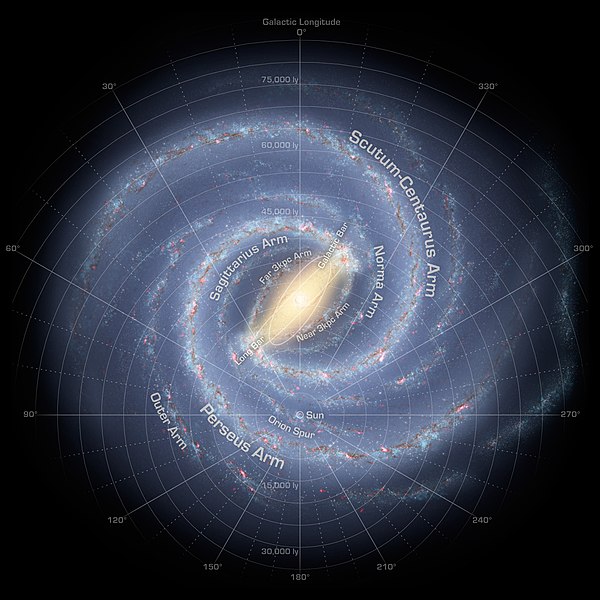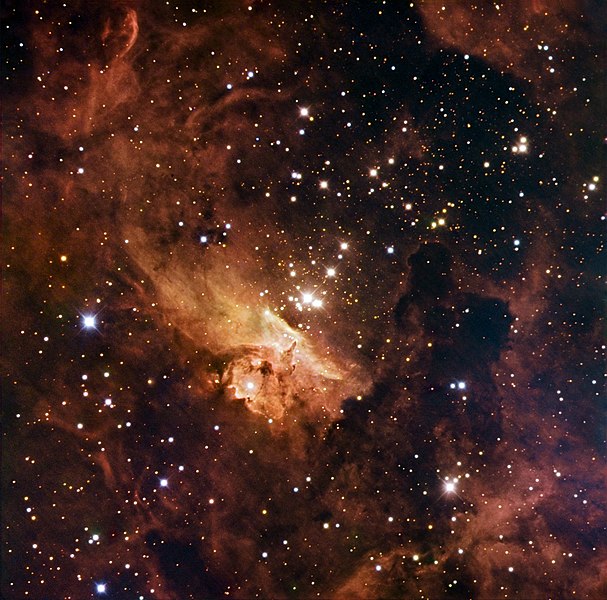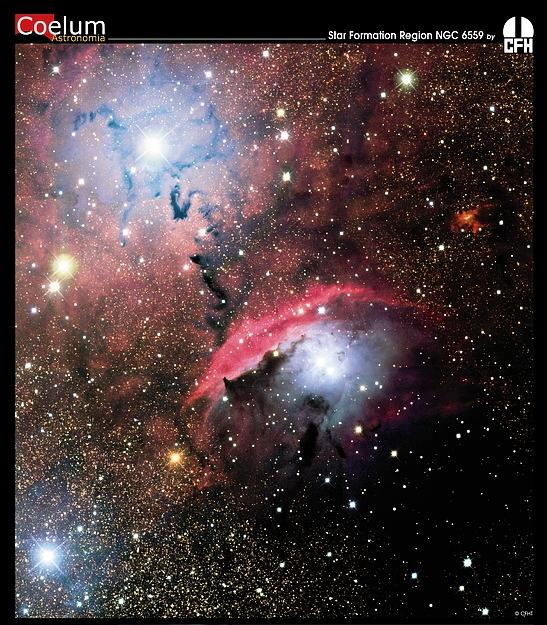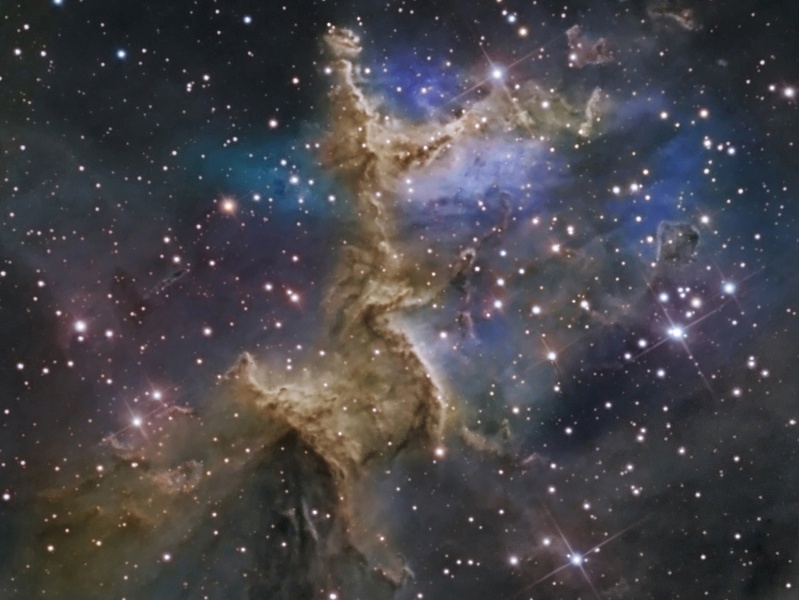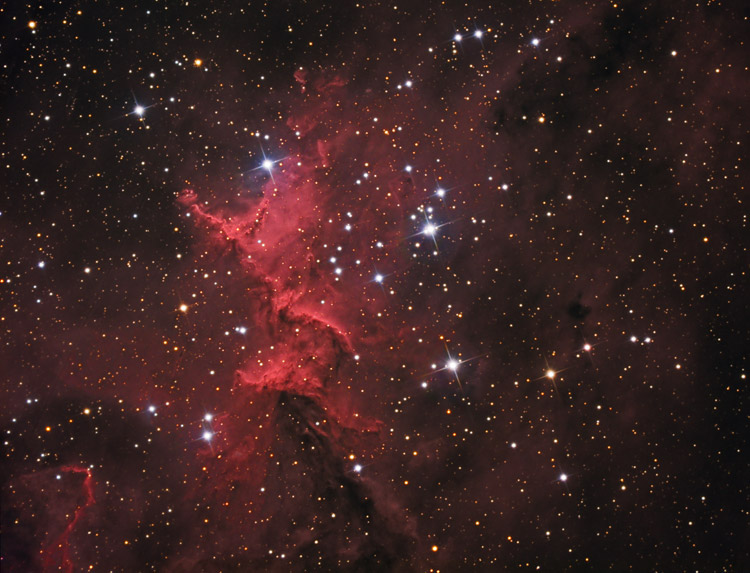Page 1 of 2
APOD: A Massive Star in NGC 6357 (2010 Nov 21)
Posted: Sun Nov 21, 2010 5:06 am
by APOD Robot
 A Massive Star in NGC 6357
Explanation:
A Massive Star in NGC 6357
Explanation: For reasons unknown, NGC 6357 is forming some of the most massive stars ever discovered. One such massive star, near the center of
NGC 6357, is
framed above carving out its own interstellar castle with its energetic light from surrounding gas and dust. In the
greater nebula, the intricate patterns are caused by
complex interactions between
interstellar winds,
radiation pressures,
magnetic fields, and
gravity. The overall glow of the nebula results from the
emission of light from
ionized hydrogen gas. Near the more obvious
Cat's Paw nebula, NGC 6357 houses the open star cluster
Pismis 24, home to many of these tremendously bright and blue stars. The central part of
NGC 6357 shown spans about 10 light years and lies about 8,000
light years away toward the constellation of the
Scorpion.
[/b]
Re: APOD: A Massive Star in NGC 6357 (2010 Nov 21)
Posted: Sun Nov 21, 2010 7:21 am
by Ann
APOD Robot wrote:
For reasons unknown, NGC 6357 is forming some of the most massive stars ever discovered.
Interesting and confusing.
The most massive stars are usually found inside the most massive young clusters. One of the most massive young clusters known in our galaxy is NGC 3603.

As you can see, NGC 3603 is a very crowded cluster, full of stars. And the biggest stars inside this cluster are enormously massive.
http://en.wikipedia.org/wiki/NGC_3603-A1 writes about a super-massive binary in NGC 3603:
NGC 3603-A1 is a massive, double-eclipsing binary star system located in NGC 3603, about 20,000 light years from Earth. Its two component stars circle each other every 3.77 days. The mass of NGC 3603-A1a is 116 ± 31 solar masses and 89 ± 16 solar masses for NGC 3603-A1b.[2] This makes them the two most massive stars directly measured so far, i.e. their masses have been determined (using Keplerian orbits), and not estimated. Both show an emission-line spectrum (spectral type WN6h).
Interestingly, when you compare the picture of NGC 3603 with the picture of the massive star in NGC 6357, you can see that the star in NGC 6357 looks lonely and abandoned. Where are all its siblings? How could this lonely star become so massive?
Ann
Re: APOD: A Massive Star in NGC 6357 (2010 Nov 21)
Posted: Sun Nov 21, 2010 7:29 am
by Ann
Here is another image of NGC 6357, showing more of the cluster Pismis 24:

The brightest star in this image may be one of the most massive stars in our galaxy, according to
http://en.wikipedia.org/wiki/NGC_6357:
This nebula includes the open cluster Pismis 24, which is home to several massive stars. One of the brightest stars in the cluster, Pismis 24-1, was thought possibly to be the most massive on record, approaching 300 solar masses, until it was discovered to be a triple star, with large components exceeding 100 solar masses.[4] The central star in the nebula is actually one of the most massive known, with a mass exceeding 200 solar masses.
The cluster still looks really star-poor. I really wonder how Pismis 24-1 could grow so massive.
Ann
Re: APOD: A Massive Star in NGC 6357 (2010 Nov 21)
Posted: Sun Nov 21, 2010 11:58 am
by inertnet
"For reasons unknown"
Could the reason be that it's possibly a low density dark matter region?
Re: APOD: A Massive Star in NGC 6357 (2010 Nov 21)
Posted: Sun Nov 21, 2010 1:33 pm
by neufer
http://en.wikipedia.org/wiki/Night_on_Bald_Mountain wrote:
<<Night on Bald Mountain is a composition by Modest Mussorgsky that exists in at least two versions—a seldom performed 1867 version or a later (1886) and very popular "fantasy for orchestra" arranged by Nikolai Rimsky-Korsakov, A Night on the Bare Mountain (Ночь на лысой горе, Noch' na lysoy gorye). The Russian word "лысая" (lïsaya) literally means "bald", but is used in this case figuratively for a mountain supposedly barren of trees. In English, the titles A Night on the Bare Mountain or Night on Bald Mountain are used.
Inspired by Russian literary works and legend, Mussorgsky made a witches' sabbath the theme of the original tone poem, completed on June 23, 1867 (St. John's Eve).
A sheet of paper apparently found among Mussorgsky's manuscripts contains the following statement: "Program of the opera St. John's Night, in three acts, after the tale by Gogol, written by P. Boborykin, in the presence and with the help of Modest Mussorgsky, Yevgeny Mussorgsky, and Vasily. Witness to the proceedings: Mily Balakirev." This curious fragment, dated December 25, 1858, has been interpreted as an indication of Mussorgsky's intention of writing an opera on the subject of Gogol's short story St. John's Eve (Russian: Вечер накануне Ивана Купала, Vecher nakanune Ivana Kupala, St. John's Eve). Gogol's tale contains the elements of witchcraft common to other stories in the Evenings on a Farm near Dikanka collection, but does not, as is often claimed, feature a witches' sabbath. Although Mussorgsky may have composed thematic sketches for this project, his plans were not mentioned.
Rimsky-Korsakov declares in his memoirs (Chronicle of My Musical Life) that in the early 1860s Mussorgsky had written a version of the Night on Bald Mountain music for piano and orchestra, under the influence of
Franz Liszt's Totentanz. However, it is believed that Mussorgsky did not hear Liszt's work until 1866, by which time he was planning the orchestral tone poem St. John's Night on the Bare Mountain. No trace of a work for piano and orchestra has survived outside Rimsky-Korsakov's recollections, so it is assumed that the score was lost, or, more likely, that it had never existed.
In 1866 Mussorgsky wrote to Balakirev expressing a desire to discuss his plans for The Witches, his informal name for his Night on Bald Mountain music. In early June 1867, he began composing the orchestral version of the piece, and finished the score on 23 June (St. John's Eve). He described the event in a letter to Vladimir Nikolsky:
"My St. John's Night on the Bare Mountain is, in form and character, Russian and original; and I want to feel sure that it is thoroughly in keeping with historic truth and Russian folk tradition — otherwise it would not be good enough. I wrote it quickly, straight away in full score without preliminary rough drafts, in twelve days. It seethed within me, and I worked day and night, hardly knowing what was happening within me. And now I see in my wicked prank an independent Russian product, free from German profundity and routine, and, like my Savishna, grown on our country's soil and nurtured on Russian bread."
Russian legend tells of a witches' sabbath taking place on St. John's Night (June 23–24) on the Lysa Hora (Bald Mountain), near Kiev:
"So far as my memory doesn't deceive me, the witches used to gather on this mountain, gossip, play tricks and await their chief — Satan. On his arrival they, i.e. the witches, formed a circle round the throne on which he sat, in the form of a kid, and sang his praise. When Satan was worked up into a sufficient passion by the witches' praises, he gave the command for the sabbath, in which he chose for himself the witches who caught his fancy."
Having finally completed the work, Mussorgsky was crushed when his mentor Mily Balakirev was savagely critical of it. The score of this 'first version' was put aside, and did not appear in print until 1968.
In the years after Mussorgsky's death, his friends prepared his manuscripts for publication and created performing editions of his unfinished works to enable them to enter the repertoire. The majority of the editorial work was done by Rimsky-Korsakov, who in 1886 produced a redacted edition of A Night on the Bare Mountain from the Dream Vision of the Peasant Lad vocal score and premiered at the first of the Russian Symphony Concerts:
“Subterranean sounds of unearthly voices. Appearance of the Spirits of Darkness, followed by that of Chornobog. Glorification of Chornobog and celebration of the Black Mass. Witches’ Sabbath. At the height of the orgy, the bell of the little village church is heard from afar. The Spirits of Darkness are dispersed. Daybreak.” —Nikolay Rimsky-Korsakov>>
Re: APOD: A Massive Star in NGC 6357 (2010 Nov 21)
Posted: Sun Nov 21, 2010 1:57 pm
by neufer
APOD Robot wrote:
<<NGC 6357 houses the open star cluster
Pismis 24, home to many of these tremendously bright and blue stars. The central part of
NGC 6357 shown spans about 10 light years and lies about 8,000 light years away toward the constellation of the
Scorpion.>>
8,000 light years would put NGC 6357
in the bright Scutum–Centaurus Arm:
http://en.wikipedia.org/wiki/Scutum%E2%80%93Centaurus_Arm wrote:
<<The Scutum–Centaurus Arm (also known as Scutum-Crux arm), is a long, diffuse curving streamer of stars, gas and dust that spirals outward from the proximate end of the long Milky Way bar. As the Milky Way is classified as a barred spiral galaxy, this feature is termed a spiral arm. It is one of two major spiral arms, and it lies between the minor Carina–Sagittarius Arm and Perseus Arm—the second major arm. The Scutum–Centaurus Arm arm starts near the core as the Scutum Arm, then gradually turns into the Centaurus Arm.
The region where the Scutum–Centaurus Arm arm connects to the bar of the galaxy is rich in star-forming regions. In 2006 a large cluster of new stars containing 14 red supergiant stars was discovered there and named RSGC1. In 2007 a cluster of approximately 50,000 newly formed stars named RSGC2 was located only a few hundred light years from RSGC1; it is thought to be less than 20 million years old and contains 26 red supergiant stars, the largest grouping of such stars known. Other clusters in this region include RSGC3 and Alicante 8.>>
Re: APOD: A Massive Star in NGC 6357 (2010 Nov 21)
Posted: Sun Nov 21, 2010 2:02 pm
by owlice
neufer wrote:The Stokowski arrangements are only rarely heard today, Rimsky-Korsakov's orchestratrion being the concert favorite.
The NSO performed the Stokowski arrangement summer of last year at Wolf Trap. It was great fun! They also did two other Stokowski arrangements, Schubert
Ave Maria and Bach
Toccata and Fugue. Also on the program,
Prelude to the Afternoon of a Faun and
Carmina Burana. Fun, fun program!
Re: APOD: A Massive Star in NGC 6357 (2010 Nov 21)
Posted: Sun Nov 21, 2010 3:56 pm
by neufer
owlice wrote:neufer wrote:
Russian legend tells of a witches' sabbath taking place on St. John's Night (June 23–24) on the Lysa Hora (Bald Mountain), near Kiev:
"So far as my memory doesn't deceive me, the witches used to gather on this mountain, gossip, play tricks and await their chief — Satan. On his arrival they, i.e. the witches, formed a circle round the throne on which he sat, in the form of a kid, and sang his praise. When Satan was worked up into a sufficient passion by the witches' praises, he gave the command for the sabbath, in which he chose for himself the witches who caught his fancy."
The Stokowski arrangements are only rarely heard today.
The NSO performed the Stokowski arrangement summer of last year at Wolf Trap.
It was great fun! Also on the program,
Carmina Burana. Fun, fun program!
And here I thought that that broomstick gag was just a joke.

Art Neuendorffer
P.S., Edward de Vere died on St. John's Day, 1604 and was subsequently deposed by a bald mountebank.
Re: APOD: A Massive Star in NGC 6357 (2010 Nov 21)
Posted: Sun Nov 21, 2010 6:47 pm
by owlice
neufer wrote:
And here I thought that that broomstick gag was just a joke.

Art Neuendorffer
P.S., Edward de Vere died on St. John's Day, 1604 and was subsequently deposed by a bald mountebank.
And I thought the throne thing you had going on was just a joke, too, but seeing was believing!
Re: APOD: A Massive Star in NGC 6357 (2010 Nov 21)
Posted: Sun Nov 21, 2010 9:08 pm
by neufer
owlice wrote:
I thought the throne thing you had going on was just a joke, too, but seeing was believing!
-----------------------------------------------------------------
_____ King Henry VI, Part iii Act 1, Scene 1
KING HENRY VI: And shall I stand, and thou sit in my *THRONE*?
-----------------------------------------------------------------
_____ Measure for Measure Act 5, Scene 1
DUKE VINCENTIO: let the devil
. Be sometime honour'd for his burning *THRONE*!
-----------------------------------------------------------------
Re: APOD: A Massive Star in NGC 6357 (2010 Nov 21)
Posted: Mon Nov 22, 2010 5:42 am
by Ann
As for NGC 6357, the shape of this nebula bears witness to the fact that it hosts extremely massive stars. NGC 6357 is "torn and tattered at the edges":
Another super-famous nebula is also "torn and tattered":

It would appear that when the stars inside a nebula are massive enough, they produce the kind of super-furious stellar winds that simply "break the nebula apart".
Close to NGC 6357 is the more famous Cat's Paw nebula. Its rounded shape bears witness to the fact that the stars that are born inside are not as monstrously massive as those inside NGC 6357:

The Cat's Paw nebula does not produce quite as massive stars as NGC 6357, and it is more rounded in shape.
Ann
Re: APOD: A Massive Star in NGC 6357 (2010 Nov 21)
Posted: Mon Nov 22, 2010 2:00 pm
by DavidLeodis
I am a bit confused (as usual

). Is the very bright star in the APOD part of Pismis 24 or not

. Clicking on the APOD brings up a larger field-of-view image that is also reproduced in an earlier post by Ann in which it states it "is another image of NGC 6357, showing more of the cluster Pismis 24". The "showing more" would seem therefore to imply that the bright star in the APOD is part of Pismis 24. Thanks for any help.
PS. Lovers of diffraction spikes will like the larger image that is brought up when clicking on the APOD.

Re: APOD: A Massive Star in NGC 6357 (2010 Nov 21)
Posted: Mon Nov 22, 2010 2:30 pm
by Ann
DavidLeodis wrote:I am a bit confused (as usual

). Is the very bright star in the APOD part of Pismis 24 or not

. Clicking on the APOD brings up a larger field-of-view image that is also reproduced in an earlier post by Ann in which it states it "is another image of NGC 6357, showing more of the cluster Pismis 24". The "showing more" would seem therefore to imply that the bright star in the APOD is part of Pismis 24. Thanks for any help.
I'm not sure I can help you, but here is my take on it.
Let's start with the Orion Nebula and the well-known Trapezium cluster at the center of it.

The Trapezium cluster. The five brightest stars here are the ones that power the Orion Nebula.
All right, but take a look at the upper right corner of the picture. Here is a reddish area and a notable yellowish star. This yellow star is actually a massive star in the process of forming, but it has not "broken out of its natal cocoon" yet, and it is only detectable in infrared light. (It could well be that it is detectable in X-rays. too.)
The important point is that the infrared star in Orion is younger than the stars of the Trapezium. It is not yet a fully-fledged star, and it is not a member of the Trapizium. But once it breaks out of its natal cocoon, what then? Will it be a member of the Trapezium cluster once it is a true main-sequence star? I think not, because it is younger than the members of the Trapezium and it is also physically separate from them. It is close to them but not close enough to be a part of their cluster, or so I think.
The situation in today's APOD is somewhat similar, except that the star featured in today's APOD is not an infrared star. It is detectable in visible light. The remnants of its natal cocoon are easily visible around the star, but the gas and dust does not hide the star from view. But I'd say that it is clearly younger than the members of Pismis 24. It was not born at the same time and not out of exactly the same dust cloud.
My opinion is that the star in today's APOD should probably not be regarded as a true member of Pismis 24. Then again, Pismis 24 is very distant, and it is certainly very possible that all the stars that are visible close to the obvious members of Pismis 24 were also counted as members of it by the man who named the cluster, Mr. Pismis himself.
Ann
Re: APOD: A Massive Star in NGC 6357 (2010 Nov 21)
Posted: Mon Nov 22, 2010 2:36 pm
by neufer
DavidLeodis wrote:
I am a bit confused (as usual

). Is the very bright star in the APOD part of Pismis 24 or not

. Clicking on the APOD brings up a larger field-of-view image that is also reproduced in an earlier post by Ann in which it states it "is another image of NGC 6357, showing more of the cluster Pismis 24". The "showing more" would seem therefore to imply that the bright star in the APOD is part of Pismis 24.
I am assuming that the 8,000 light year distant stars of "star cluster Pismis 24" have pushed aside the NGC 6357 nebula gases such that all the bright stars in today's APOD diffuse nebula are simply unrelated foreground stars.
http://en.wikipedia.org/wiki/NGC_6357#Pismis_24 wrote:
<<NGC 6357 is a diffuse nebula near NGC 6334 in the constellation Scorpius. This nebula was given the name War and Peace Nebula by the Midcourse Space Experiment scientists because of its appearance. They said that in infrared images the bright, western part resembles a dove, while the eastern part looks like a skull. The nebula contains many proto-stars shielded by dark disks of gas, and young stars wrapped in expanding "cocoons".>>
Jerry: I read the most unbelievable thing about Tolstoy the other day,
did you know the original title for "War and Peace"
was "War--What Is It Good For?"!
Elaine: Ha ha.
Jerry: No, no.. I'm not kidding Elaine it's true, his mistress didn't
like the title and insisted him change it to "War and Peace"!
Elaine: But it's a line from that song!
Jerry: That's were they got it from!
Re: APOD: A Massive Star in NGC 6357 (2010 Nov 21)
Posted: Mon Nov 22, 2010 3:19 pm
by DavidLeodis
Thanks Ann for your reply, which is appreciated. My conclusion (probably wrong though!) is that the bright star in the APOD is not part of the Pismis 24 cluster. I had also wondered about the name Pismis, so it is good to know it is named after Mr Pismis.

Thanks also neufer, though, as is often the case, I get more confused than ever on reading your replies to posts. They do however make interesting readings.

Re: APOD: A Massive Star in NGC 6357 (2010 Nov 21)
Posted: Mon Nov 22, 2010 4:02 pm
by neufer
DavidLeodis wrote:
I had also wondered about the name Pismis, so it is good to know it is named after Mr Pismis.

Is there a Mrs Pismis

Re: APOD: A Massive Star in NGC 6357 (2010 Nov 21)
Posted: Mon Nov 22, 2010 4:39 pm
by Ann
I found a Hubble palette image of NGC 6357. Very strange.
Usually I'm quite bored by Hubble palette images, and I will rarely praise them. But they can be useful at times. For example, you can normally expect a nebula to look blue close to an O star if the nebula is shown in the Hubble palette. That is because blue color represents oxygen emission in the Hubble palette, and oxygen emission is usually only present around hot O-type stars. So the blue color of a nebula shown in the Hubble palette tells you that an O star is probably located here.
Well, I found an image of NGC 6357 in the Hubble palette. Guess what? The nebula surrounding the star in today's APOD
is not blue!!! Instead the nebula is yellow from a combination of hydrogen and nitrogen. The hydrogen and nitrogen emission combined with the lack of oxygen strongly suggests to me that the star, impressive-looking as it is, is in fact not an O-type star. Most likely it is an early B-type star instead.
The stars in Pismis 24 are also not surrounded by blue light. My guess is that this cluster has blown away the gas and dust that surrounded it.
But an area of strong nebulosity between Pismis 24 and the star in today's APOD is brightly turquoise, suggesting emission of both oxygen, hydrogen and nitrogen. Also, a "cavity" to the right of Pismis 24, to the right of some dark dusty pillars, is strongly blue! Where does this blue light come from????
Something tells me that I may possibly not be allowed to post the image I found, which is why I did my best to describe it. Here, however, is the image, and let's see how long it lasts:
Ann
Re: APOD: A Massive Star in NGC 6357 (2010 Nov 21)
Posted: Mon Nov 22, 2010 5:23 pm
by DavidLeodis
neufer wrote:DavidLeodis wrote:
I had also wondered about the name Pismis, so it is good to know it is named after Mr Pismis.

Is there a Mrs Pismis

Or even a Miss Pismis.

Sorry all for that rhyming bit of fun but some of you were bound to at least think it, so I thought it might as well be me that posted it!

Re: APOD: A Massive Star in NGC 6357 (2010 Nov 21)
Posted: Mon Nov 22, 2010 5:26 pm
by lewcook
Has anyone noticed/commented on/worked on the resemblance of one lobe of the Cat's Paw to the Homunculus around eta Carina? This is best seen in
http://antwrp.gsfc.nasa.gov/apod/ap080304.html
and hinted at in
http://antwrp.gsfc.nasa.gov/apod/ap100421.html
Re: APOD: A Massive Star in NGC 6357 (2010 Nov 21)
Posted: Mon Nov 22, 2010 5:34 pm
by DavidLeodis
I've just found that the APOD image is part of that used for the APOD of 2008 October 26 which was titled 'Massive Stars in Open Cluster Pismis 24'. That APOD is the larger field-of-view image that is brought up through clicking on the APOD.
http://antwrp.gsfc.nasa.gov/apod/ap081026.html The explanation to the APOD of 2008 October 26 clearly indicates that the bright star in the APOD of 2010 November 21 is not part of Pismis 24.
Re: APOD: A Massive Star in NGC 6357 (2010 Nov 21)
Posted: Mon Nov 22, 2010 6:18 pm
by Ann
Here is another image of Pismis 24 and the star in today's APOD:
The bluish-pink area in the middle of the picture is exactly the part of the nebula that was strongly turquoise in the Hubble palette image of NGC 6357. This is the most highly ionized part of the nebula.
So the most highly ionized part of the nebula is
between hot stars and clusters, not
inside clusters or right next to the newborn stars! This reminds me of a star forming region in Sagittarius, NGC 6559:
Isn't this interesting? At upper left you have a bright blue star surrounded by tendrils of dust and a reflection nebula. There is also a large and relatively faint emission nebula centered on it. The star, HD 165921, is alternatively classified as spectral type B6, B0 and O8! Personally I think B0 sounds best, based on the appearance of the nebula. (I fail to see how a B6 star could create an emission nebula at all.)
At the center of the image you have some newborn stars, surrounded by blue reflection nebulosity. I think that the brightest star inside may be HD 166107, classified as a B5 star, which sounds about right based on the appearance of the reflection nebula surrounding it.
But now look at that amazingly bright red "arc" surrounding the B5 star and its siblings like a shell. What causes this strong hydrogen emission? My own guess is that it might be the collision of the stellar wind from the B0 star at top and the young cluster of B-type stars in the bright blue reflection nebula. None of the B-type stars in this picture is able to create a strong emission nebula on its own, but when stellar winds collide hydrogen will glow very red!
Similarly, in today's APOD, it could be that the colliding stellar winds create the strong emission nebula between the cluster and the star inside a cavity of gas and dust.
Ann
Re: APOD: A Massive Star in NGC 6357 (2010 Nov 21)
Posted: Mon Nov 22, 2010 9:44 pm
by neufer
Ann wrote:
Here is another image of Pismis 24 and the star in today's APOD:
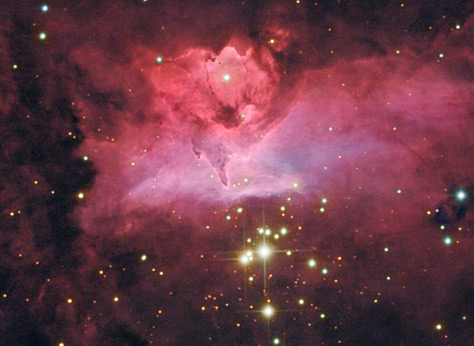
The bluish-pink area in the middle of the picture is exactly the part of the
nebula that was strongly turquoise in the Hubble palette image of NGC 6357.
This is the most highly ionized part of the nebula.
http://antwrp.gsfc.nasa.gov/apod/ap081009.html
http://antwrp.gsfc.nasa.gov/apod/ap061220.html
http://antwrp.gsfc.nasa.gov/apod/ap991207.html
Re: APOD: A Massive Star in NGC 6357 (2010 Nov 21)
Posted: Tue Nov 23, 2010 2:18 am
by GaryR
Ann wrote:
Similarly, in today's APOD, it could be that the colliding stellar winds create the strong emission nebula between the cluster and the star inside a cavity of gas and dust.
Ann
Huh? I thought it was the intense ultraviolet light from the massive stars that causes the emission nebula. Stellar wind just blows the gas away.
Gary
Re: APOD: A Massive Star in NGC 6357 (2010 Nov 21)
Posted: Tue Nov 23, 2010 4:31 am
by Ann
GaryR wrote:Ann wrote:
Similarly, in today's APOD, it could be that the colliding stellar winds create the strong emission nebula between the cluster and the star inside a cavity of gas and dust.
Ann
Huh? I thought it was the intense ultraviolet light from the massive stars that causes the emission nebula. Stellar wind just blows the gas away.
Gary
Sometimes colliding stellar winds can indeed make gas and dust "pile up" and make it glow with emission.
This link will take you to APOD from July 26, 2008:
http://apod.nasa.gov/apod/ap080726.html
Here is the same picture, but without the caption:
The gas and dust has become piled up because there are hot massive stars on both sides on it, blowing on it with their furious stellar winds.
As you can see, the picture is in the Hubble palette. There is a lot of blue color in the vicinity of the stars, showing oxygen emission, and testifying to the fact that there are several O stars in here. But the piled-up gas and dust isn't blue, but yellowish. This part of the nebula is completely dominated by hydrogen and sulphur emission.
In traditional RGB photography, the piled up gas and dust between the hot stars in IC 1805 glows very red:
Clearly, though, the highly ionized part of the nebula near Pismis 24 isn't as dusty as the piled-up "walls" between the hot stars in IC 1805.
Actually, oxygen emission is only possible in a very rarified environment, where there is basically no dust and extremely little gas. Could it be that the star sitting in that "cave" in today's APOD is indeed an O star after all, but that there is just too much "gunk" in that cave for the star to be able to ionize the oxygen in its vicinity?
Ann
Re: APOD: A Massive Star in NGC 6357 (2010 Nov 21)
Posted: Tue Nov 23, 2010 4:34 am
by Ann
Art, space is full of owls. I'm just saying...!
(And thanks for the links!)
Ann
 A Massive Star in NGC 6357
A Massive Star in NGC 6357


